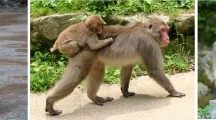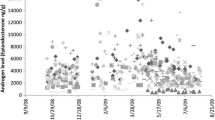Abstract
Several aspects of breeding-season relationships with mature females are described for free-ranging immature male rhesus monkeys (Macaca mulatta)on Cayo Santiago. At puberty, immature males are still groomed by mature females, as they were as infants, but no longer receive active protection from females other than their mothers. A further, potentially beneficial, aspect of their associations with females lies in the opportunities to observe closely the tactical social and sexual interactions of receptive females with adult males. However, immature males themselves rarely copulate with females. Developmental constraints may explain the finding that most females observed by immature males were relatives but that high-ranking males showed a particular preference for adolescent relatives, whereas the preference of low-ranking males was for adult relatives. A further finding was that while there was a tendency for immature males to devote a greater proportion of their total observation time to females that ranked above their mothers than to those of inferior rank, these were also the females from which males received the most aggression, while most of the females with which the males groomed or copulated were lower ranking than the males’ mothers. Of three hypotheses concerning three possible types of social constraint which might account for such a finding, the data supported only one—that particular levels of aggression within these relationships are compatible only with certain other elements (observations), and not with others (grooming, copulation).
Similar content being viewed by others
References
Altmann, J. (1974). Observational study of behaviour: Sampling methods.Behaviour 49: 227–267.
Altmann, J. (1980).Baboon Mothers and Infants, Harvard University Press, Cambridge, Mass.
Berman, C. M. (1980a). Mother-infant relationships among free-ranging rhesus monkeys on Cayo Santiago: A comparison with captive pairs.Anim. Behav. 28: 860–873.
Berman, C. M. (1980b). Early agonistic experience and rank acquisition among free-ranging infant rhesus monkeys.Int. J. Primatol. 1: 153–170.
Carpenter, C. R. (1942a). Characteristics of social behavior in nonhuman primates.Trans. N. Y. Acad. Sci. 4: 249–258.
Carpenter, C. R. (1942b). Sexual behavior of free-ranging rhesus monkeys (Macaca mulatto): Specimens, procedures, and behavioral characters of estrus.J. Comp. Psychol. 33: 143–162.
Cheney, D. L. (1978). Interactions of immature male and female baboons with adult females.Anim. Behav. 26: 389–408.
Chevalier-Skolnikoff, S. (1971). Homo- and heterosexual behavior in stumptail monkeysMacaca speciosa. Paper presented at the symposium on Biological and Cultural Bases of Sex Role Differentiation, AAAS, Philadelphia.
Colvin, J. D. (1982).Social Integration and Emigration of Immature Male Rhesus Macaques, Unpublished Ph.D. thesis, University of Cambridge, Cambridge.
Colvin, J. D., and Tissier, G. F. (1985). Affiliation and reciprocity in sibling and peer relationships among free-ranging immature male rhesus monkeys.Anim. Behav. 33: in press.
Datta, S. (1981).Dynamics of Dominance Among Free-Ranging Rhesus Females, Unpublished Ph.D. thesis, University of Cambridge, Cambridge.
De Benedictis, T. (1973). The behavior of young primates during adult copulation: Observations of aMacaca irus colony.Am. Anthrop. 75: 1469–1484.
De Vore, I. (1965). Male dominance and mating behavior in baboons. In Beach, F.A. (ed.),Sex and Behavior, Holt, Rinehart and Winston, New York, pp. 53–110.
Itoigawa, N. (1975). Variables in male leaving a group of Japanese macaques. In Kondo, S., Kawai, M., Ehara, A., and Kawamura, S. (ed.),Symp. 5th Congr. Int. Primatol Soc, Japan Science Press, Tokyo, pp. 233–245.
Glick, B. B. (1980). Ontogenetic and psychobiological aspects of the mating activities of maleMacaca radiata. In Lindburg, D.G. (ed.),The Macaques: Studies in Ecology, Behavior and Evolution, Van Nostrand and Reinhold, New York, pp. 345–369.
Gouzoules, H. (1974). Harassment of sexual behavior in the stumptail macaqueM. arctoides. Folia primatol. 17: 208–217.
Hall, K. R. L. (1965). Behavior and ecology of the wild patas monkey,Erythrocebus patas, in Uganda.J. Zool. 148: 15–87.
Hanby, J. P. (1976). Sociosexual development in primates. In Bateson, P. P.G., and Klopfer, P.H. (ed.)Perspectives in Ethology, Vol. 2, Plenum Press, London, pp. 1–67.
Hinde, R. A. (1974).Biological Bases of Human Social Behavior, McGraw-Hill, New York
Hinde, R. A. (1978). Interpersonal relationships-In quest of a science.Psychol. Med. 8: 373–386.
Hinde, R. A., and Atkinson, S. (1970) Assessing the roles of socialp)artners in maintaining mutual proximity, as exemplified by mother-infant relations in monkeys.Anim. Behav. 18: 169–176.
Hiraiwa, M. (1981). Maternal and alloparental care in a troop of free-ranging Japanese monkeys.Primates 22: 309–329.
Jay, R. (1963). Mother-infant relations in langurs. In Rheingold, H. L. (ed.),Maternal Behavior in Mammals, Wiley, New York, pp. 282–304.
Keverne, E. B. (1976). Sexual receptivity and attractiveness in monkeys. In Rosenblatt, J.S., Hinde, R.A., Shaw, E., and Beer, C. (ed.),Advances in the Study of Behavior, Vol. 7, Academic Press, New York, pp. 155–200.
Lee, P. C. (1981).Ecological and Social Influences on the Development of Vervet Monkeys, Unpublished Ph.D. thesis, University of Cambridge, Cambridge.
Loy, J., and Loy, K. (1977). Sexual harassment among captive patas monkeys (Erythrocebus patas). Primates 18:691–699.
Owens, N. (1973).The Development of Behaviour in Free-Living Baboons, Papio anubis, Unpublished Ph.D. thesis, University of Cambridge, Cambridge.
Packer, C. (1979). Inter-troop transfer and inbreeding avoidance inPapio anubis. Anim. Behav. 27: 1–36.
Pusey, A. E. (1983). Mother-offspring relationships in chimpanzees after weaning.Anim. Behav. 31: 363–377.
Ransom, T. W., and Rowell, T. E. (1972). Early social development of feral baboons. In Poirier, F.E. (ed.),Primate Socialization, Random House, New York, pp. 105–144.
Rose, R. M., Bernstein, I. S., Gordon, T. P., and Lindsley, J. G. (1978). Changes in testosterone and behavior during adolescence in the male rhesus monkey.Psychosom. Med. 40: 60–70.
Rosenblum, L. A. (1971). Kinship interaction patterns in pigtail and bonnet macaques.Proc. 3rd Int. Congr. Primatol., Vol. 3, Karger, Basel, pp. 79–84.
Rowell, T. E. (1967). Female reproductive cycles and the behavior of baboons and rhesus macaques. In Altmann, S.A. (ed.),Social Communication Among Primates, University of Chicago Press, Chicago, pp. 15–22.
Sade, D. S. (1967). Determinants of dominance in a group of free-ranging rhesus monkeys. In Altmann, S.A. (ed.),Social Communication Among Primates, University of Chicago Press, Chicago, pp. 99–114.
Sade, D. S., Cushing, K., Dunaif, J., Figeroa, A., Kaplan, J. R., Lauer, C., Rhodes, D., and Schneider, J. (1976). Population dynamics in relation to social structure on Cayo SantiagoYb. phys. Anthrop. 20: 235–262.
Seyfarth, R. M. (1978). Social relationships among adult male and female baboons, II. Behavior throughout the female reproductive cycle.Behavior 64: 227–247.
Seyfarth, R. M. (1980). The distribution of grooming and related behaviours among adult female vervet monkeys.Anim. Behav. 28: 798–813.
Siegel, S. (1956).Nonparametric Statistics, McGraw-Hill, Tokyo.
Silk, J. B., Samuels, A., and Rodman, P. S. (1981). The influence of kinship, rank and sex on affiliation and aggression between adult female and immature bonnet macaques (Macaca radiata). Behaviour 78: 111–137.
Simpson, M. J. A., and Simpson, A. E. (1977). One-zero and scan methods of sampling behaviour.Anim. Behav. 25: 726–731.
Spencer-Booth, Y. (1970). The relationships between mammalian young and conspecifics other than mothers and peers. In Lehrman, D.S., Hinde, R.A., and Shaw, E. (ed.),Advances in the Study of Behavior, Vol. 3, Academic Press, London, pp. 120–194.
Struhsaker, T. T. (1967). Social structure among vervet monkeys.Behaviour 29: 83–121.
Struhsaker, T. T. (1971). Social behaviour of mother and infant vervet monkeys (Cercopithecus aethiops). Anim. Behav. 19: 233–250.
Tutin, C. E. G. (1979). Mating patterns and reproductive strategies in a community of wild chimpanzees (Pan troglodytes schweinfurthii). Behav. Ecol. Sociobiol. 6: 29–38.
van Lawick-Goodall, J. (1967). Mother-offspring relationships in free-ranging chimpanzees. In Morris, D. (ed.),Primate Ethology, Weidenfeld and Nicholson, London, pp. 287–346.
Walters, J. (1980). Interventions and the development of dominance relationships in female baboons.Folia primatol. 34: 126–136.
Author information
Authors and Affiliations
Rights and permissions
About this article
Cite this article
Colvin, J.D. Breeding-season relationships of immature male rhesus monkeys with females. I. Individual differences and constraints on partner choice. Int J Primatol 6, 261–287 (1985). https://doi.org/10.1007/BF02745500
Received:
Revised:
Issue Date:
DOI: https://doi.org/10.1007/BF02745500




